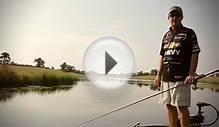
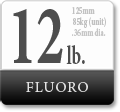
Knowing just what dimensions and kind line for various baits is crucial.
Is top fisherman you can be, you must know which tools are right for the job. The BassFishin.Com Line Guide establishes off to give you the best fishing line alternatives for various lures and techniques. In this guide, we start thinking about monofilaments, braids, plus the newest generation of fishing lines, fluorocarbons. All three line types tend to be distinctly various and also have their own unique pro’s and con’s. If plumped for correctly for the presentation, you'll see noticeable gains inside success on the liquid.
As you might find various line selections for each lure or presentation, this Line Guide is meant to-be really specific so you can buy and spool your reels with the most efficient range for baits you wish to fish. This guide is also dead handy for those fishermen who've few rods, as you can easily see the possible combinations of range that you can spool up that supply you with the best versatility when it comes to presentations you foresee your self fishing the essential often inside figures of liquid.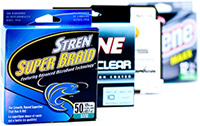 While flexibility is essential, The BassFishin.Com Line Guide was created to convey the necessity of getting line choice right together with huge effect correct range option can have in putting more fish inside watercraft. It generates an impact.
While flexibility is essential, The BassFishin.Com Line Guide was created to convey the necessity of getting line choice right together with huge effect correct range option can have in putting more fish inside watercraft. It generates an impact.
How To Use The Line Guide:
For every lure or rig, you will see the recommended line alternatives for the very best presentation. Some baits have very certain guidelines, although some have numerous options which can be acceptable under various problems. We do our far better explain the variations in line options for such lures. You'll find any helpful records or frequently asked questions within the package beneath the line guidelines. Utilize this Guide before you spool up your reels or when you are buying your line to help you result in the most readily useful choices.
Must I Go With Fluorocarbon or Mono?
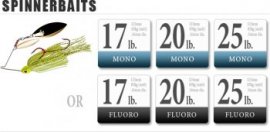 There is currently a debate as to which regarding the two lines is way better for spinnerbaits. Some fishermen, like Kevin VanDam, favor monofilament due to its buoyancy. Because mono floats, you can easily maintain the spinnerbait nearer to the outer lining more easily, particularly on long casts. It is crucial that you keep a spinnerbait close to the area so seafood can’t obtain a good glance at the lure, and mono lets you repeat this effortlessly.
There is currently a debate as to which regarding the two lines is way better for spinnerbaits. Some fishermen, like Kevin VanDam, favor monofilament due to its buoyancy. Because mono floats, you can easily maintain the spinnerbait nearer to the outer lining more easily, particularly on long casts. It is crucial that you keep a spinnerbait close to the area so seafood can’t obtain a good glance at the lure, and mono lets you repeat this effortlessly.
Other anglers, like Skeet Reese, prefer fluorocarbon over mono whenever fishing spinnerbaits because of its enhanced sensitivity, reduced stretch and greater invisibility. The normal drawback of fishing spinnerbaits on fluorocarbon is you're usually required to make use of a “high tip” to keep the spinnerbait close to the surface. A “high tip” is not the ideal pole place for establishing the hook, and therefore the reason why many fishermen favor monofilament.
Exactly Why Is Fluorocarbon Preferred Here?
The three huge benefits fluorocarbon has actually for superficial cranking is higher abrasion-resistance, lower-stretch which is significantly less noticeable to fish. Because superficial crankbaits are usually fished through more substantial address, fluorocarbon will resist scratching significantly more than mono. Because it is low-stretch, you’ll feel much more bites and have the crankbait coming through cover better. Some of fishermen, including some top pro’s, choose monofilament for assorted explanations when low cranking. One of these brilliant explanations is mono’s high-stretch, which will allow you to “pop” or “bowstring” your appeal out-of snags more regularly. Besides this explanation, there isn’t much else that should sway you far from utilizing fluorocarbon.
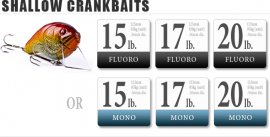 Why these types of heavy outlines?
Why these types of heavy outlines?
Shallow cranking is mainly carried out in hefty cover or snaggy environments. You’ll be pulling your crankbait through brush, stumps, and so on. Your line has to stand up to the abuse and give you the power for fish in amongst hefty address.
I thought mono ended up being better given that it stretched?
Monofilament had been very long employed for crankbaits given that it stretched and aided not pull the trebles out from the fish’s mouth on hooksets and fish fighting. While this ended up being truly an advantage, many fishermen these days realize utilizing a medium-action pole (or composite cranking pole) with a soft tip gives the fish the play it must perhaps not pull the hooks away. With all the appropriate rod, you can get away because of the low-stretch that Fluorocarbon exhibits.
The “sink” aspect:
Besides the “invisibility” factor, fluorocarbon sinks and will create your crankbaits run 1-3+ feet deeper than with monofilament. This will be a huge advantage. Fluorocarbon is several of the most abrasion-resistant range available on the market too, so working baits around stones, zebra mussels, etc. is good with this specific range.
Must I choose 40 or 65? Or somewhere in between?
We at BassFishin.Com strongly advise focusing your frog and toad fishing at 50 pound test. We like 40 pound test for when you really need to create extremely lengthy casts to cover reasonably simple weedbeds that don’t pose much risk to dropping fish. Small diameter will include a few extra foot towards casts that may let you cover more liquid. Usage 65 whenever fishing closer timber or docks. 50 lb test is the ultimate in-between size that work all over the place and in any scenario.
When Fluorocarbon is the best choice:
Fluorocarbon should really be your starting place for the majority of figures of liquid and presentations. It’s invisibility and low-stretch offers you the advantage you will need over mono.
When should I use mono?
Mono is very buoyant and so is perfect for when you need be effective the swimbait right up near the area. Mono comes with a lot of stretch, which are often placed to your advantage in the event that seafood are increasingly being finicky rather than slamming the appeal once they bite. Usually bass will press the bait or be slow to completely engulf these large swimbaits, and monofilament offers you the excess time you'll want to allow the seafood get it with it’s mouth before you decide to set the hook. You'll want to give them a moment before setting the hook, and mono guarantees you don’t pull it from them too rapidly.
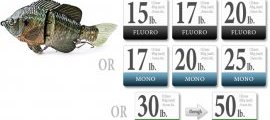
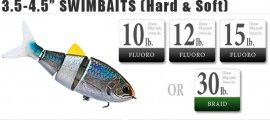
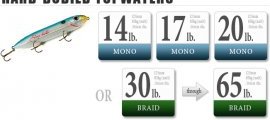
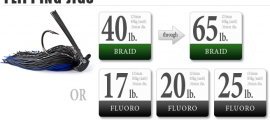
RELATED VIDEO


